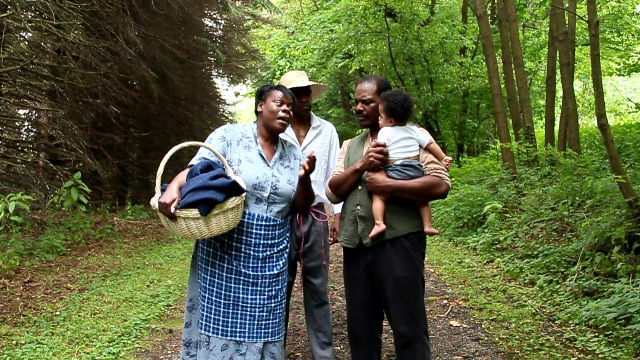Canton Actors Bring a Remarkable Couple to Life

The actors, from the left, are: Roslyn Pratt, who plays Nancy; Doyle Walker, who plays James (in the background); and Rufus Malone, who plays Henry. Henry and Nancy’s child is played by Joshua Daniel Johnson.
When a friend first approached Roslyn Pratt about playing Nancy Brown in the Canton film production of The Disappearing Man, her first reaction was “Oh no, you don’t.” Based on her extensive stage experience, Pratt knew how demanding it could be to take an acting role on top of her full-time job teaching English to adults.
But she was curious about trying a film role, so she threw herself into the part with gusto, even composing one of the songs for The Disappearing Man–a story based on the true tale of Henry “Box” Brown, a slave who mailed himself to freedom. In 1849, with the help of two friends, Brown was sealed in a wooden box and escaped by being shipped from Richmond, Virginia, to Philadelphia.
A cast of 35 from the Canton area spent this past summer filming a one-hour version of The Disappearing Man, the novel chosen for October’s One Book, One Community program. The film will be shown October 27 at 7 p.m. in the Memorial Chapel at Malone University’s Johnson Center, 2600 Cleveland Ave., in Canton.
One of the biggest challenges was finding two leads who could both act and sing, for the real Henry Brown was a powerful singer in his church choir in Richmond. But Frank Motz, the director, says they found the right people in Rufus Malone, who plays Henry, and Pratt, who plays Henry’s wife Nancy.
Pratt, a Canton native, has been acting for 15 years, and she has been singing even longer–since she was four years old. She’s been singing professionally since age 17.
“I was a student at Ohio State, but I quit when someone offered me five hundred dollars a week to sing,” Pratt recalls.
Her parents were shocked at the time, but she eventually finished her degree in education in 1999, and she supported herself as a professional singer from age 17 until three years ago. “I sang professionally all over the country, even going to Germany, Spain, Switzerland, and France, singing Gospel,” she says.
During that time, Pratt worked for some famous bosses, singing backup for Dennis Edwards, the lead singer for the Temptations, when he went solo. She also sang for Jack McDuff, a renowned jazz musician, and she performed for well-known motivational speaker Les Brown. In the midst of these adventures, she even recalls living in a New York apartment above the legendary comic, Richard Pryor.
In The Disappearing Man, Pratt finds herself acting in the company of another comic, because her co-star, Rufus Malone, has been a stand-up comedian for 16 years, primarily working in Ohio and New York.
“Rufus was a great person to have on set,” says the director, Motz. “While waiting for us to get something straightened out on the set, he would have us in stitches doing stand-up comedy.”
Malone retired from the Ford Motor Company and now works professionally as an actor on stage and in TV and film, in addition to his comedy act–“although if you ask my mother, she’d say I’ve been acting all my life.”
According to Malone, some of the most intense scenes in The Disappearing Man were when Henry had run-ins with John Allen, the brutal overseer at the Richmond factory where Henry Brown worked. Malone says the scenes clicked because he had already acted with the man playing John Allen, Ross Rhodes.
“We had the chemistry. We knew how to play off of each other,” he says.
Another key scene was when Henry Brown risked his safety by slipping out in the middle of the night to serenade Nancy. Pratt wrote the song that Malone sings to her as Henry Brown.
“I’ve studied the roots of African-American music, so I have an idea of what it sounds like,” she says. “I also did some research on what was going on during that era.”
In addition to singing and writing one of the songs, Pratt introduced Motz to the Voices of Unity Community Choir, led by Minister John B. Wright, Jr. The choir performed in the film; and as Motz says, “When I entered the church to check them out, I could hear the full force of their singing, and I almost fell over. They’re wonderful.”
Both Malone and Pratt went to great lengths to put themselves in the time period of 1849–although Malone was glad he didn’t have to be sealed completely inside the box. When those scenes were filmed, the box always had one side open to provide access for the camera, taking away some of the claustrophobia and confinement.
“Putting myself back in that era was the greatest challenge,” Malone says. “Man, it was a struggle back then.”Â
By Doug Peterson
